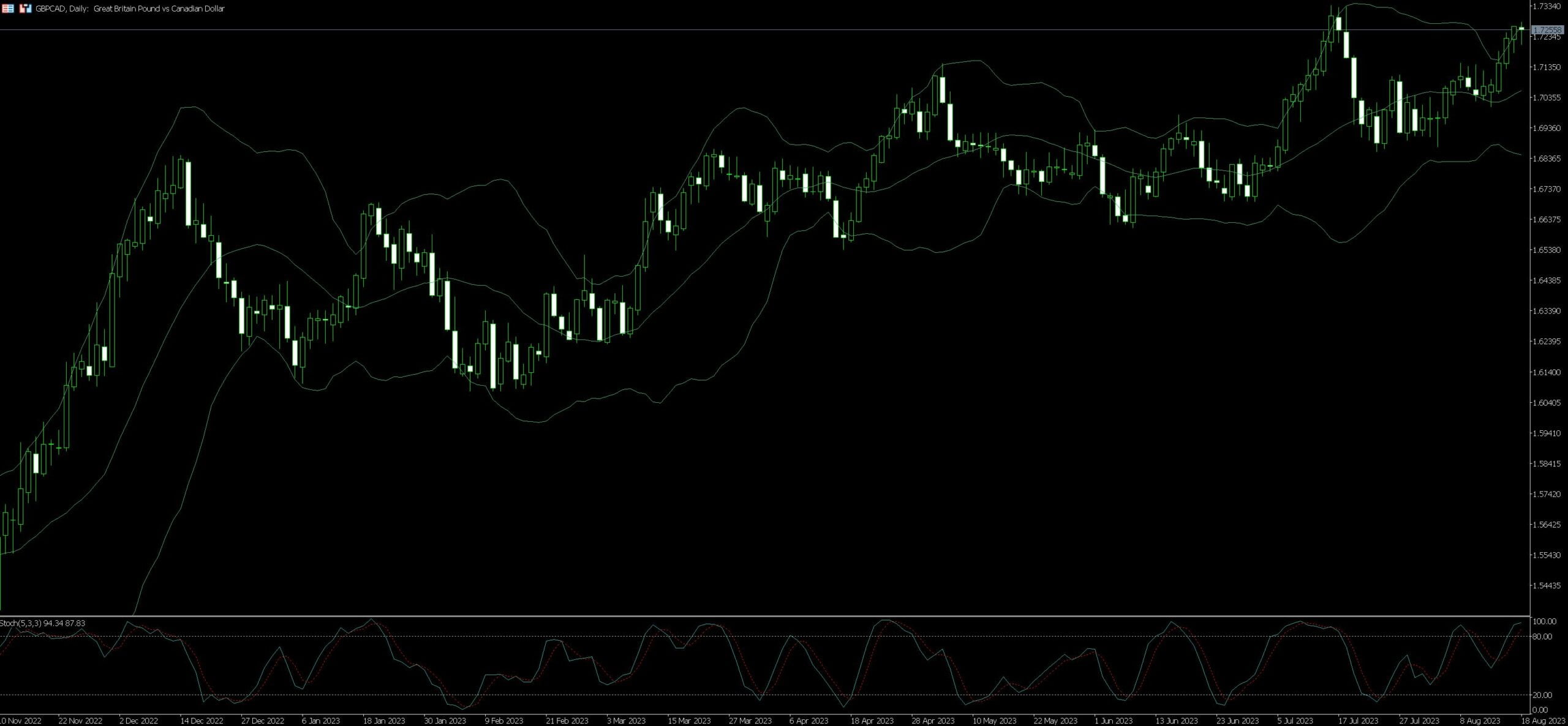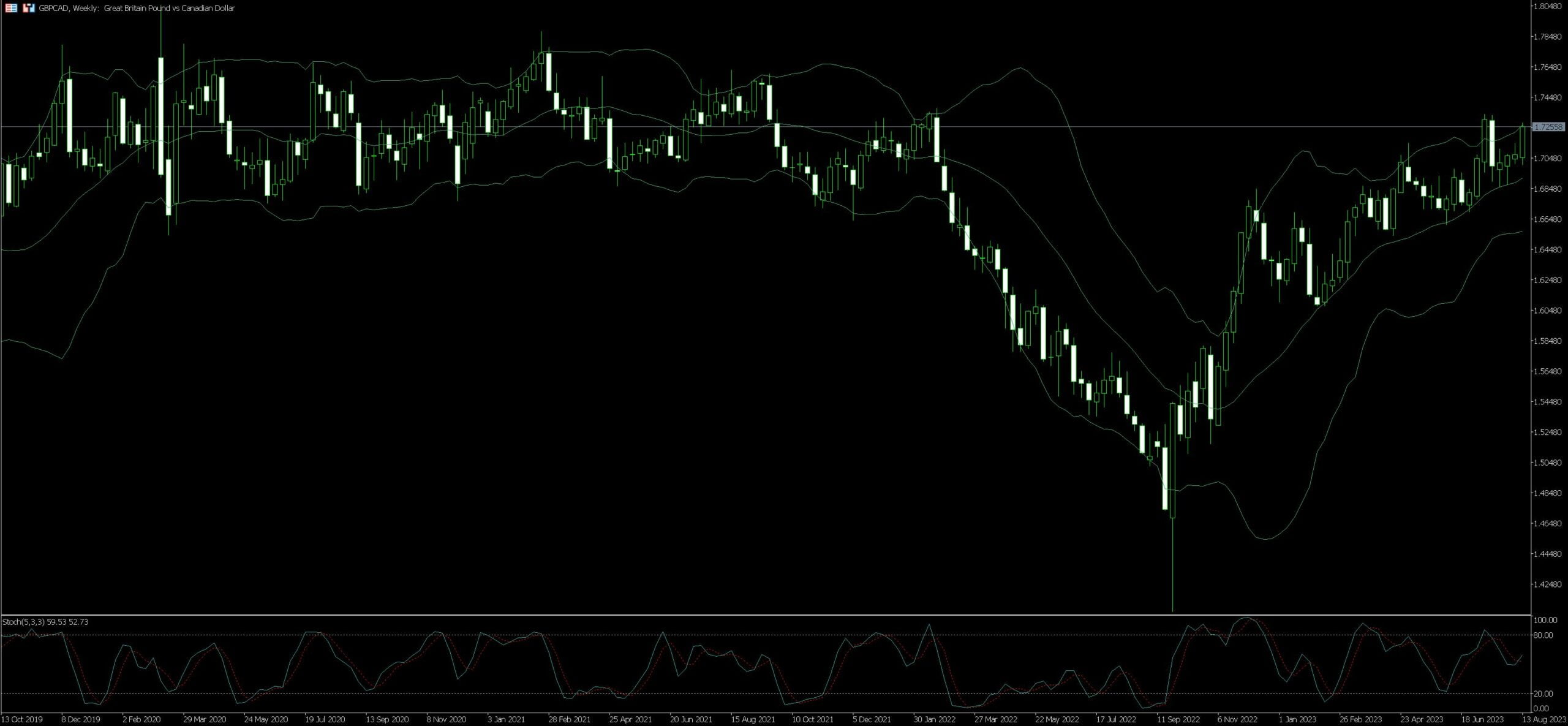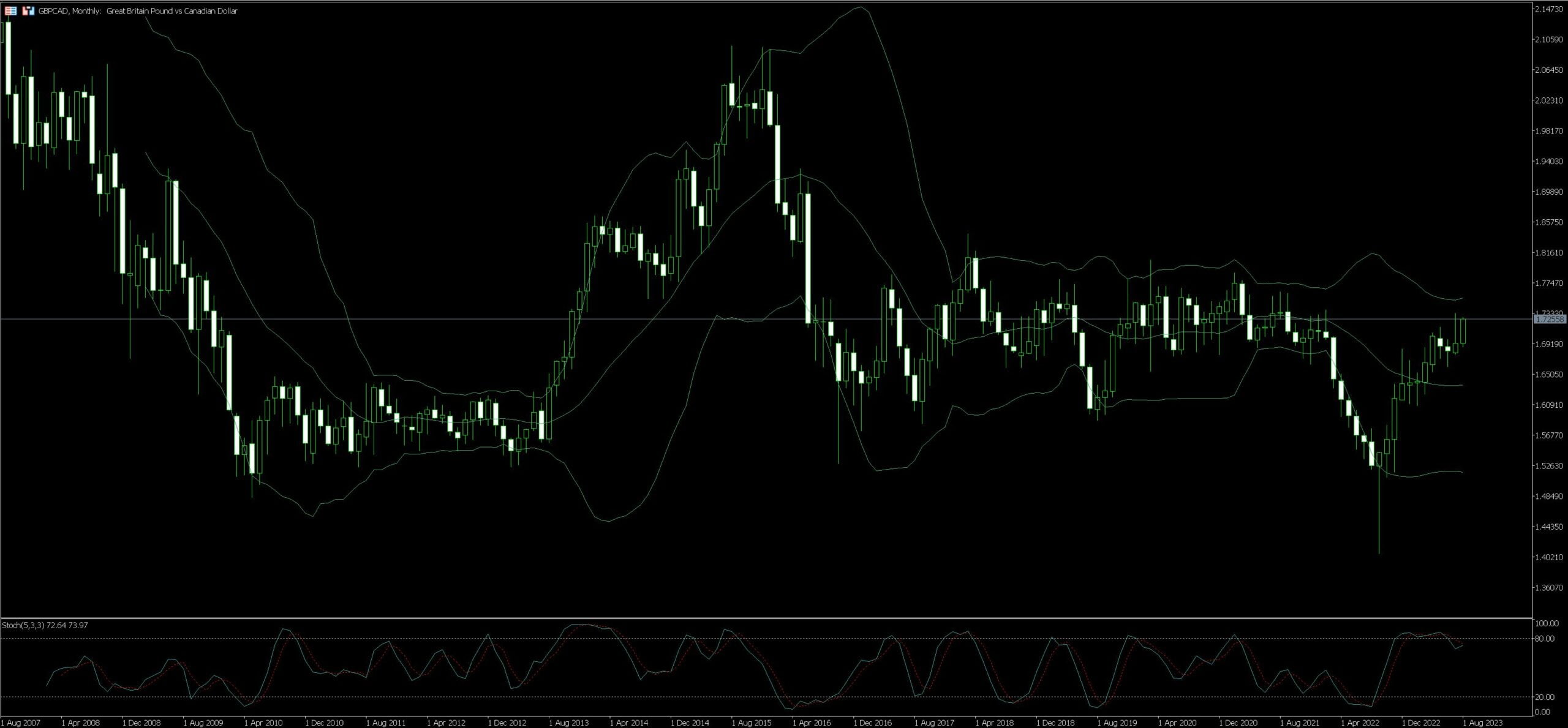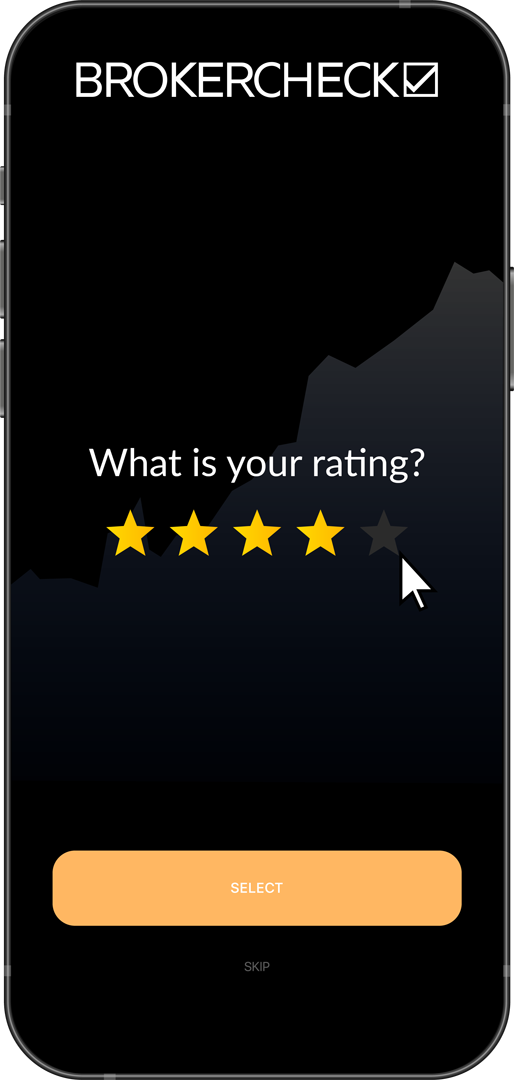Live Chart Of GBP/CAD
1. Understanding the GBP/CAD Forex Pair
The GBP/CAD Forex pair may seem complex at first, but with the right knowledge, trading it can become a fruitful endeavor. The pair represents the value of the British pound (GBP) against the Canadian dollar (CAD). The GBP, often referred to as the ‘cable’, is known for its volatility. The currency of one of the world’s largest economies, it often sees substantial movements resulting from releases of economic data and changes in Bank of England monetary policy. Conversely, the CAD is firmly tied to the economic health of Canada and its key export, crude oil.
While trading this pair, both currencies demand attention. The CAD draws its strength from fluctuations in oil prices due to Canada’s heavy reliance on its oil exports, making it a so-called ‘commodity currency’. Any changes in oil prices, or geopolitical events affecting them, will have a significant impact on the value of the CAD.
On the other hand, the GBP is sensitive to economic indicators such as Gross Domestic Product, inflation, and unemployment rates. Regular monitoring of these indicators is crucial for predicting potential movements in GBP’s value. Key events to look out for include statements from the Bank of England, especially any hint of changes in interest rates or quantitative easing policies.
The GBP/CAD pair is an excellent venue for those who appreciate volatility and can tactfully predict the outcomes of prominent economic events. Careful analysis of economic indicators, crude oil prices, and geopolitical events can provide traders with a profound understanding of the pair’s behavior, enabling them to make informed trading decisions.

1.1. Importance of GBP and CAD Currencies
GBP and CAD currencies represent two potent economies: the United Kingdom and Canada. The British Pound (GBP) remains one of the major players in the global financial markets due to the UK’s significant contributions to global economics. High-value commodities like gold, oil, and manufacturing contribute substantially to their economy. With the UK as a member of the G7 and G20, the GBP holds vital importance in any forex trading pair.
CAD, the Canadian dollar, is not left out in this equation. Canada’s economy, heavily laden with natural resources, promotes the prevalence of CAD. This economy heavily depends on global natural resource demand and commodity prices, specifically oil. Therefore, any shifts in these areas significantly impact the CAD’s value. Sturdy ties to the United States, one of the largest economies globally, further solidify CAD’s position in the trading world.
When trading GBP/CAD, understanding the macroeconomic factors influencing the value of these currencies is crucial. Changes in interest rates, economic reports, political stability, and global commodity prices can all cause fluctuations in this trading pair’s value. By keeping a pulse on these elements, traders can make informed decisions, helping to maximize their returns on the GBP/CAD trading pair. It is also important to harness technical analysis tools, understanding support and resistance points, and employing risk management strategies while trading this volatile pair. This approach allows traders to gain an edge while navigating the choppy waters of GBP/CAD trading. Therefore, the importance of GBP and CAD currencies in the realm of forex trading cannot be overstated.
1.2. Factors Influencing GBP/CAD Value
Fluctuations in the value of the GBP/CAD can be traced back to a variety of factors, ranging from economic performance to geopolitical events. The state of the economy in both the United Kingdom and Canada play a vital role in determining the currency pair’s value. This includes factors such as Gross Domestic Product (GDP), employment levels, and inflation rates. Notably, the Bank of England and Bank of Canada’s policy decisions, especially those concerning interest rates and quantitative easing, also have a significant impact.
Additionally, as major global powers, events occurring within the UK and Canada’s borders can influence the pair’s value. This is particularly true for applicable political events such as elections, political crises, and policy changes. Cross-Atlantic trade relations and economic treaties also have a role to play. It is therefore vital for traders to stay updated on current events and economic performance indicators in both nations.
The commodities market also has a bearing on the GBP/CAD’s value. Given Canada’s standing as a leading exporter of resources such as oil and gas, changes in commodity prices can result in noticeable shifts. If the price of oil were to increase, for example, the Canadian Dollar would typically strengthen, thereby affecting the GBP/CAD value.
Lastly, sentiments and speculation on the forex market often lead to changes in the value of the GBP/CAD pair. This is due to the inherent subjectivity and uncertainty linked to trading. Traders’ sentiment towards the UK and Canadian economies, often influenced by global economic forecasts, political developments, and unforeseen events, greatly affect how the currency pair moves. As a result, mastering the ability to gauge market sentiment can be an invaluable tool for any trader dealing in GBP/CAD.
1.3. Historical Performance of GBP/CAD
GBP/CAD, a currency pair known for its characteristic volatility, holds a fascinating historical performance. The fluctuations in this pair can be attributed to factors as varied as economic policy to geopolitical events, directly impacting the value of Sterling (GBP) against the Canadian Dollar (CAD). Between 2000 and 2002, the pair surged from 2.02 to a peak of 2.42 due to economic stability in the UK compared to a period of uncertainty in Canada.
The financial crisis of 2008, triggering a global recession, led to a sharp fall of GBP/CAD – dropping from 2.069 to 1.589 within a short span. Despite this dramatic descent, the pair rebounded remarkably by 2013, leaping to 1.819 following the economic recovery in the UK.
Meanwhile, an interesting dynamic came into play during the UK’s Brexit referendum in 2016, creating a notable dent and causing the GBP/CAD to temporarily plummet to 1.585 owing to the uncertainty revolving around Brexit. The subsequent years saw the GBP/CAD oscillating between 1.592 and 1.779, and reacting to vital influences like shifts in oil prices, a major component of Canada’s economy, and ongoing Brexit talks.
Sporting a rather turbulent trend, the GBP/CAD pair’s historical performance presents attractive opportunities to traders who can capitalize on its volatility. Whether trading long or short, a comprehensive understanding of these past trading patterns can provide critical insights for profitable trading decisions. Navigating the choppy waters of the GBP/CAD does not only require a grasp of fundamental underlying factors; it equally mandates a watchful eye on unfolding global events that could trigger the next wave of volatility.
The GBP/CAD pair’s dynamic background reinforces the necessity of robustly analyzing market trends and economic indicators. Making profitable trades in this pair entails constant monitoring of market shift and the potential impact of new geopolitical and economic events. This approach, coupled with a thorough comprehension of its historical performance, will empower traders to make the most of trading opportunities offered by the ever-volatile GBP/CAD pair.
2. Approach towards Trading GBP/CAD

Deep comprehension of both the British Pound (GBP) and the Canadian Dollar (CAD) is crucial when trading GBP/CAD. The GBP is influenced by the economy, politics, and Bank of England’s policy decisions, while the CAD follows oil price trends being a commodity-dominated economy. Stay informed about global news impacting these countries and automate trades where possible to capitalize on real-time changes.
Understanding chart patterns and technical indicators forms another key piece of the trading approach. The common candlestick patterns such as Doji, Hammer, and Shooting Star alongside indicators like Relative Strength Index (RSI) and Moving Average Convergence Divergence (MACD) can provide valuable insight into market trends.
Risk management should never be ignored, as it’s the lifeline of trading. Use stop-loss orders to limit potential losses, and take-profit levels to secure profits when a certain price level is reached. Position sizes should align with the risk tolerance and overall trading strategy, and one should never risk more than they can afford to lose.
Consider practice with a demo account, especially for beginners. Experimenting with strategies, understanding market impacts, and refining skills without the risk of actual financial loss. Hence, attaining considerable experience, and confidence prior to engaging in live trading.
Paying attention to key economic data pertaining to both the UK and Canada, such as employment reports, GDP figures, interest rate announcements, and oil prices news directly influence the GBP/CAD pair. Keeping a close watch on these factors can help traders make informed decisions and improve the consistency of their trading results.
Also, it’s advisable to watch out for sudden price fluctuations. Although seeing a potential windfall can be enticing, it comes with the risk of significant losses. Employing a disciplined and patient approach in trading will help in managing emotions and maintaining focus on sound trading practices. Patience is particularly essential in waiting for the right trading opportunities, which contributes to the success of trading GBP/CAD.
Lastly, traders should adopt a flexible trading strategy that adapts to market shifts as and when they occur. Given the unpredictable and dynamic nature of forex markets, a rigid trading plan may not serve best interests. A trading plan should therefore be reviewed and adjusted regularly to ensure it remains effective.
2.1. Understanding Forex Market Hours
The glorious aspect of the forex market is that it runs 24 hours a day and five days a week. This allows traders unparalleled flexibility in executing trades at any hour of the day or night. Ascertaining the peculiarities of market hours, particularly for specific currency pairings such as GBP/CAD, is paramount for every shrewd trader.
The principal market hours are broken into three noteworthy sessions: the Tokyo session, the London session, and the New York session. Notably, each session’s opening and closing hours will correlate with the operating hours of the representative equity market. Utilise a forex trading hour’s tool to keep an eye on changes in volatility to successfully strategize your next steps.
A popular aspect of the GBP/CAD currency pair is that it has the highest liquidity during both the London and New York sessions. As GBP is the currency of the UK, the highest trading volumes are expected to appear during the London session. Likewise, the CAD, being Canada’s currency, is actively traded during the New York session, causing the GBP/CAD pair’s volatility to soar during these two sessions.
Take note of the Asian or Tokyo session as well, though GBP/CAD may see less activity during this period. Nevertheless, this doesn’t mean opportunities are non-existent. Noteworthy economic announcements or sudden market events can stir significant moves even during off-peak hours. A seasoned trader is capable of exploiting such opportunities in the GBP/CAD forex market.
The intrigue of forex lies in its perpetuity; always presenting opportunities and tempting traders to trade. However, savvy traders alert to the market hours seek to capitalize around the high volatility periods. This approach aids in navigating through the potentially tumultuous seas of the GBP/CAD trading landscape. This understanding of forex market hours is just one of the many pieces in the complex jigsaw puzzle that is successful, sustained forex trading.
2.2. Types of Trading Strategies
Trend Trading emerges as one of the most popular strategies for trading GBP/CAD. It banks on the idea that the currency pair will maintain its direction over time. Traders identify the overall trend of the market, position their trade, and stay with it until the trend changes. What makes trend trading effective is consistent analysis and being in for the long haul. Patience plays a key role in reaping positive results with this strategy.
Another approach in trading GBP/CAD is Swing Trading. Often seen as a medium-term strategy, this method capitalizes on price “swings” or changes in trend. Swing traders, unlike trend traders, don’t necessarily follow a clear trend but seek opportunities in price fluctuations. The exciting aspect of swing trading lies in its ability to yield profits in an unstable market. Traders gain from both the upward and downward market movements.
Scalping offers a shorter-term trading strategy. This high-speed trade method centers on making small, frequent profits off minor price changes and is accordingly considered one of the fastest trades. While scalping may seem difficult for beginners due to its speed, it has the potential for quick gains when performed correctly.
Seasonal Trading, like its name implies, recognizes patterns based on the time of year or season. This strategy is driven by periodic events such as major announcements related to the GBP/CAD pair. Despite the complexity of correctly identifying the patterns, the technique offers remarkable payouts when the seasonal shifts are accurately predicted.
Range Trading takes advantage of the fact that prices usually move within a certain range or channel. Traders using this method spot support and resistance levels to buy or sell accordingly. While range trading can be risky during volatility, it’s highly effective in a stable market.
2.3. Pivotal Role of Forex Analysis
Often overlooked, the integral role of Forex Analysis cannot be understated when hoping to consistently profit from the GBP/CAD pair. It involves interpreting the financial, political, and economic aspects that might shape the currency market. Deciphering between myriad influential factors within both the British and Canadian economies can be likened to unravelling complex mathematical equations. Fundamental analysis, for example, evaluates economic indicators, including GDP, unemployment rates, and monetary policies, while technical analysis explores price actions and patterns to predict future movement.
Trading GBP/CAD demands a keen understanding of both the UK and Canadian markets, along with their respective currencies. The trends and fluctuations within these economies are undeniably crucial in informed trading decisions—ignoring such can be costly. Incorporating Forex analysis leads to identifying opportunities or threats which may influence investment choices.
It’s crucial to realize that drawing conclusions solely based on immediate price movements might lead to imminent losses. A thorough Forex analysis can indeed provide a more comprehensive view of the market, thereby enhancing the decision-making process. It’s not about chasing the trend but understanding it—grasping what might be brewing beneath the surface.
GBP/CAD trading is not without uncertainties; thus, it’s essential to be updated with economic events that can lead to unpredictability. Potential volatility should not be confrontational but a stepping stone towards profitable trading. After all, successful GBP/CAD trading is not merely based on luck but on understanding the intricate dance of the global economy.
3. Risk Management in GBP/CAD Trading

In the world of forex, it is common to spot traders buying pounds and selling Canadian dollars. However, a part of ensuring success in your trades is careful risk management. Avoiding such practices could lead to disastrous effects. This is especially crucial when trading in volatile pairs like the GBP/CAD.
Set stop-loss orders during your trades. These are a type of order, which automatically closes your position when losses reach a certain threshold. This way, even if the market moves against your prediction, your losses are limited and can prevent your trading account from dropping to low levels.
Additionally, it is recommended to employ the use of leverage with caution. While leverage can increase your profits manifold, it also carries equivalent risks of multiplying your losses. Hence, only use this financial instrument if you fully understand its implications and have the capability to mitigate its inherent risks.
Another important aspect of risk management involves not risking more than a small percentage of your trading capital in a single trade. As a good rule of thumb, do not risk more than 2% of your trading capital per trade. This ensures that even if you face a series of unsuccessful trades, your trading account will not be wiped out and you can bounce back.
Also, remain updated regarding the economic events both in the U.K. and Canada. These events can significantly affect the GBP/CAD pair. Having an awareness of the schedule of such events can help you prepare and plan your trading strategies accordingly.
Proper risk management in GBP/CAD is not merely an optional strategy; rather it’s a prerequisite for any trader aiming for long term success. Put your risk management practice at the centre of your trading activity and you are already halfway to becoming a successful trader.
3.1. Utilizing Stop Loss and Take Profit Orders
Trading GBP/CAD can seem like a high-stakes game, but with the right strategy in hand, it’s a game where one can master. Understanding the utilization of Stop Loss and Take Profit Orders is key to managing risks and securing profits in the volatile currency market.
A Stop Loss order is your safety net in trading. It curtails your losses if the market moves against your position. For example, if a trader buys GBP/CAD at 1.6500, they might place a stop loss order at 1.6400. This means if the GBP/CAD falls to 1.6400 or below, the trading platform would automatically sell at the best available price. The application of stop loss orders protects traders from significant losses during sudden market shifts.
Conversely, Take Profit orders lock in your gains when you’re not immediately available to do so. This tool guarantees the realization of a certain level of profit once the currency pair reaches a pre-set level. If you have a long position on GBP/CAD and set a take profit order at 1.6600, your position will be automatically closed and your profit realized once the price hits that level.
Between the two, a balance must be struck – using stop loss orders to manage risk, while applying take profit orders to secure profits. They’re paramount for maintaining a degree of control in the otherwise unpredictable landscape of Forex trading. Every trader should make utilization of these important tools on their trades.
Never underestimate the power of these imperative orders while trading GBP/CAD or any other currency pair. Stop Loss and Take Profit orders aren’t just optional extras, they’re important aspects of every successful trading strategy.
3.2. Importance of Risk to Reward Ratio
Establishing a trusted method when trading GBP/CAD is crucial. One such method is recognizing the importance of the Risk to Reward Ratio. This ratio provides a clear, quantitative measure for risks compared to potential rewards.
More often than not, novice traders incline towards opportunities promising high rewards, paying little heed to potential risks. This can often result in heavy losses. On the other hand, by taking a more balanced approach and employing the principles of Risk to Reward Ratio, traders can objectively assess each trade’s potential to ensure that the potential reward outweighs the risk.
For example, a Risk to Reward Ratio of 1:3 indicates that the potential profit is three times the risk. In this scenario, even if a trader is correct only 50% of the time, they would still be in profit over an extended series of trades. This is due to the profits on successful trades, outweighing the losses incurred from unsuccessful ones.
By implementing Risk to Reward ratios, traders can enforce discipline in their trading strategy, creating a safety net against impulsive decisions. A well-defined ratio can be a game-changer, enabling traders to make informed trading decisions that could significantly improve their trading success in the GBP/CAD market over time.
Applying a strong Risk to Reward Ratio, with disciplined money management, is a prudent strategy while trading GBP/CAD. As long as traders prioritize managing risk over chasing unrealistic rewards, they can potentially achieve prolonged success and stability in their trading career.
3.3. Leveraging Position Sizing
Adeptly managing your trading position size in the GBP/CAD market can directly influence your financial success. Without proper risk management strategies, incurred losses can directly threaten the sustainability of your trading account. Trading with too large a position size can be riskier and could lead to significant losses. It’s where leverage comes into play.
The power of leverage allows traders to control more considerable sums of GBP/CAD currency pairs without needing the total amount of invested cash. The leverage ratio could be 50:1, 100:1, or even 500:1, depending on the broker and the size of the trade.
A key factor to consider is the potential of leverage to magnify both profits and losses. As such, traders would do well to incorporate due diligence and carefully consider their risk tolerance. For instance, if a trader opts for a 100:1 leverage ratio, it implies they can control $100 in the market for every $1 in their trading account. While it may increase profit potential, it also raises the risk of larger losses if the GBP/CAD market swings in an unfavorable direction.
Appropriate leverage and position sizing safeguard the trading account against the volatile swings of the GBP/CAD market. Striking a balance between potential profits and minimized losses should be the primary consideration of every smart trader. For optimal leveraging position sizing, one might adjust based on market volatility, the proximity of market price to stop-loss, and your trading account size. It helps in maintaining an optimal risk-reward balance. The advantage is to preserve capital, ensure longevity in the market, and cultivate a more disciplined and profitable trading routine.
Never underestimate the role of prudent leveraging and position sizing in trading the GBP/CAD currency pair. It might seem less exciting than market analysis or strategy development, but it is a crucial part of prudent trading practices and risk management.
4. Trading Platform Selection for GBP/CAD
Choosing the right trading platform acts as a pivot point in your journey towards trading GBP/CAD successfully. Renowned for its tight spreads, high liquidity and its status as one of the top currencies traded on the forex market, the GBP/CAD pair presents attractive opportunities to both experienced and novice traders.
The selection of a trading platform can significantly influence the trading experience. A platform should offer essential components such as real-time charts, technical indicators, and economic news feeds. These tools can assist traders in making informed trading decisions. Both MetaTrader 4 and MetaTrader 5, with their dynamic, user-friendly interfaces, powerful charting tools and automated trading capabilities, have risen as prime choices among forex traders.
However, the quest for the optimal platform shouldn’t end here. It’s important to find a platform that fits well with one’s unique trading style. A scalper, who trades in short-term price movements, may require a different platform than a position trader who holds positions for longer periods of time.
Finally, testing a platform before making a commitment is advisable. Most firms offer demo accounts, allowing traders to get a feel of the platform’s functionality and performance without risking real capital. This step assists in making an informed choice that nurtures successful trading in the GBP/CAD pair.
4.1. Platform Interface and Usability
The platform interface and usability play a critical role in trading GBP/CAD. Look for a state-of-the-art platform interface. In an era where immediacy is key, practicality and efficiency cannot be compromised. A sophisticated, yet user-friendly interface helps traders process information quickly, make immediate decisions, and execute trades seamlessly.
Similarly, understanding platform usability is paramount. The ability to navigate through the platform’s features smoothly is a trait of a good broker. A simple, intuitive layout that provides easy access to complex trading tools is ideal. The pricing, technical indicators, and other vital trading information should be readily available.
It’s important for traders to have live charts and instant access to real-time forex news. Both these features help traders stay ahead of the game and make informed decisions. The platform must also allow traders to customise the interface to suit their personal style and trading strategy. Traders should be able to comfortably switch between multiple screens and execute trades at the click of a button.
Moreover, the platform should have reliable customer support that can immediately address any issues or concerns. This is a non-negotiable feature. It’s essential for traders to have someone they can rely on when they encounter difficulty in executing trades.
Platforms providing a feature for setting alerts and notifications for specific trading situations also hold a competitive edge. With GBP/CAD being a highly volatile pair, traders can effectively maximize their profits and mitigate risks if they are informed promptly about the changes in the market.
In essence, whether you’re a rookie or a seasoned forex trader, the functionality, speed, and design of the platform interface significantly impacts your ability to trade GBP/CAD effectively. A user-friendly design, along with rapid processing speeds and adept customer support, can shape your trading experience and directly influence your profit potential.
4.2. Technical Indicators and Tools Availability
When diving into the complexities of trading the GBP/CAD currency pair, it is invaluable to have a vast array of technical indicators and tools at your disposal. As the market fluctuates, these tools can provide a host of analytical insights, helping to guide decision-making processes.
A fundamental technical indicator to examine is the Moving Average (MA). This tool quantifies price trends over a specified period, offering a streamlined perspective of erratic market movements. Utilizing the Moving Average, traders can observe bullish and bearish shifts in the market, providing an indication of optimal times to buy or sell.
Another vital indicator is the Relative Strength Index (RSI). This tool measures the speed and change of price movements, effectively indicating overbought or oversold conditions. A high RSI (above 70) suggests an overbought market, possibly leading to price reversal, while a low RSI (below 30) signals an oversold market, indicating a potential upward price correction.
Currency trading often employs the Bollinger Bands indicator. By identifying the ‘bands’ of the market price, relative to a central line represented by the Moving Average, this tool predicts price volatility. Broader bands are indicative of a more volatile market, while tighter bands suggest a less volatile market, providing further guidance on trade set-ups.
Superior trading additionally necessitates the application of Fibonacci Retracements. Drawing upon mathematical models, this tool tracks historical price movements to predict potential future reversals. Traders often rely on Fibonacci Retracements to place ‘stop losses’ and ‘take profit’ levels accurately.
Moreover, the MACD Indicator, which depicts the relationship between two moving averages, serves as an excellent measure of market momentum, offering further insight into the immediate course of the currency pair’s price.
Traders will find utility in a variety of other technical tools, such as pivot points, trend lines, and pitchforks, each offering unique perspectives on the behavior of the GBP/CAD pair. Embracing the wealth of technical indicators and tools available aids in establishing comprehensive, effective trading strategies for the dynamic forex market.
4.3. Customer Support and Security Measures
Navigating the world of trading in the global frontier is a complex endeavor that requires a solid support system. With GBP/CAD trading activities, trusted partners play an essential role. Addressing queries and providing suitable solutions promptly proves invaluable for traders. Customer Support provides that lifeline to traders who need assistance or encounter issues during trading. With 24-hour availability on various platforms, such as telephone, email, and live chat, this support system ensures smooth trading operations.
In trading GBP/CAD, ensuring transaction security is paramount. Several Security Measures are in place to protect traders’ investments and personal information. High-level encryption techniques safeguard traders’ data from hackers, securing it from unauthorized access. Two-Factor authentication (2FA) adds an extra layer of security when logging into trading accounts, making it harder for attackers to gain control. Additionally, setting up firewalls and regular security audits fosters a safe trading environment.
Trading platforms also use secure socket layers (SSL) to ensure safe internet connections. Information is encrypted to secure data in transit, add to that, the use of privacy policies which help delineate how personal data is processed, used, and stored. These measures work concurrently to provide a robust and secure trading arena for GBP/CAD traders. Trustworthy customer support and stringent security measures play pivotal roles in facilitating a productive and secure trading environment.
4.4. Broker Fees and Commissions
Delving deeper into trading GBP/CAD, an aspect that strikes right in the heart of every trader is the pressing concern of broker fees and commissions. These necessary expenses can be seen as the cost of accessing the financial markets and often hold a significant margin in a trader’s profit calculations.
Trading platforms typically adopt one of two main fee structures. Some charge a commission, which is a set percentage taken from each trade, and others opt for a spread-based model, where the broker makes a profit from the price difference between buying and selling rates.
The complexity and volatility of trading GBP/CAD, the sterling to Canadian dollar currency pair, heighten the importance of understanding broker fees, as these could add considerably to the cost of each trade. Informed traders scan for platforms offering competitive spreads or comparably low commissions, leading to higher net returns.
A prudent approach to managing these fees is paramount. Traders need to consider their trading frequency and strategy when choosing between low spreads or low commission structures. Day traders making high volume trades might find a lower spread more advantageous, while a casual trader might prefer a lower commission.
One must not disregard the potential occurrence of overnight fees. Those holding positions open past trading hours might encounter these additional costs. These fees depend on the interest rate differential between the GBP and the CAD and can be a significant expense for long-term traders.
Choosing the right broker with a favourable fee structure, coupled with a keen eye for precise timing and a solid knowledge of market trends, can anchor a trader in the tumultuous seas of GBP/CAD trading. The cost of doing business in the financial markets need not be a deterrent but rather a factor in shaping a profitable trading strategy.











